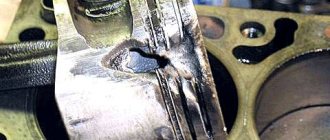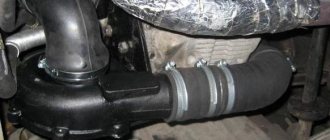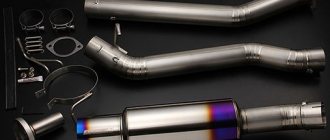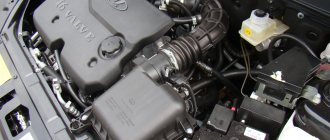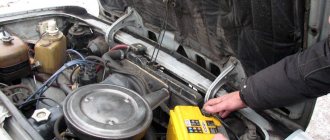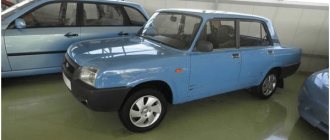VAZ 2107 is the first model of the Volzhsky Automobile Plant, which has undergone many modernizations, improvements and additions throughout the entire production period. This included replacing the engine from a carburetor to an injection engine. The only thing that remained unchanged was the exterior.
For forty years, starting in 1972, the “Seven” rolled off the plant’s assembly line. Initially produced with a 1.5 liter engine from the third model of the Zhiguli. In the process of evolution, the engine volume changed from 1.45 to 1.7 liters, but the power units were carburetor.
Only in 2006, the designers of the car plant managed to implement a distributed injection system on an engine with a volume of 1700 cc. From that time on, the era of production of cars of the Lada family with an injection engine began.
The game was worth the candle. The main thing is that the technical developers achieved what they set out to achieve:
- fuel economy;
- increase in power;
- equated to Euro-2 standards.
Subsequently, the VAZ 2107i (injector) ousted its counterparts with a carburetor power plant from production.
Characteristics of VAZ 2107
| Performance indicators | Meaning |
| Maximum speed, km/h | 150 |
| Fuel consumption l: | |
| City | 9,6 |
| Route | 6,9 |
| Mixed | 8 |
| Euro toxicity standard | Euro 2 |
| Engine | |
| Power unit volume, cm3 | 1451 |
| Fuel type | petrol |
| Number and arrangement of cylinders | 4/R |
| Supply system | Distributive injection |
| Number of valves | 8 |
| Maximum torque, N*m at rpm | 115 at 3450 |
| Maximum power, hp | 71 |
| Transmission | |
| Transmission type | Mechanical |
| Number of steps | 5 |
| type of drive | Rear |
| Suspension | |
| Front suspension device | Independent multi-link |
| Rear suspension device | Dependent, on coil springs |
| Front brake mechanism | Disk |
| Rear brake mechanism | Drum |
Initially, the seven was equipped with an engine with a capacity of 1.5 liters, but during the production process the power range was expanded.
Modifications of engines installed on the VAZ 2107.
| Options | Model range of VAZ engines | ||||
| 2103 | 2104 | 2106 | 21067 | 21067-20 | |
| Cylinder diameter, piston stroke | 76 80 | 76 80 | 79 80 | 79 80 | 79 20 |
| Working volume | 1,5 | 1,5 | 1,6 | 1,6 | 1,6 |
| Compression ratio | 8,5 | 8,5 | 8,5 | 8,5 | 8,5 |
| Supply system | carburetor | Distributive injection | carburetor | Distributive injection | Distributive injection |
| Rated power, kW | 52,5 | 52,5 | 54,8 | 54,5 | 53,5 |
| Rated speed | 5600 | 5000 | 5600 | 5000 | 5300 |
| Fuel brand | (AI-92) | (AI-92) | (AI-92) | (AI-92) | (AI-95) |
| Spark plug | A17DVR, FE65CPR, A17DV-10 | А17ДВРМ, BRISR, SUPER, LR 15YC | A17DVR, FE65CPR, A17DV-10 | А17ДВРМ, BRISR, SUPER, LR 15YC | А17ДВРМ, BRISR, SUPER, LR 15YC |
| Toxicity standard | Euro-0 | Euro 2 | Euro-0 | Euro 2 | Euro-3 |
What kind of engine can be installed on the “seven” instead of the standard one?
The driver begins to think about changing the engine when, for some reason, he is no longer satisfied with the operation of the standard equipment. In general, the 2107 model is excellent for various kinds of technical experiments and tuning, but the rational approach to choosing new equipment has not yet been canceled.
Therefore, before you even think about a new motor for your swallow, you need to weigh the pros and cons, namely:
- what goals need to be achieved when replacing a standard engine;
- are there technical capabilities to safely connect the motor;
- Is it possible to do the replacement yourself, etc.
Engines from other VAZ models
Naturally, engines from cars of the same family can be installed on the VAZ 2107i without significant modifications and loss of time. Experienced car enthusiasts advise taking a closer look at engines from:
- VAZ 2114;
- "Lada Niva";
- "Lada Priora".
These are more modern power units with an increased number of “horses”. In addition, the engine dimensions and connection connectors are almost identical to the standard equipment of the “Seven”.
Engines from foreign cars
Imported engines are rightfully considered more reliable and durable, so the idea of installing a foreign-made engine in a VAZ 2107i often excites the minds of drivers. It must be said that this idea is quite feasible if we take Nissan and Fiat models from 1975–1990 as donors.
The thing is that Fiat became the prototype of the domestic Zhiguli, so structurally they have a lot in common. And Nissan is also technically similar to Fiat. Therefore, without significant modifications, you can install engines from these foreign cars on the VAZ 2107.
Nissan Silvia is an excellent donor for the VAZ 2107i, since the procedure for replacing engines is possible without the involvement of service station specialists
Rotary power units
On "sevens" rotary engines are not that uncommon. In fact, due to the specifics of their work, rotor mechanisms can significantly optimize the operation of the VAZ 2107i and give the car acceleration and power.
An economical rotary engine ideal for the 2107 is a modification of the RPD 413i. The 1.3-liter unit develops power up to 245 horsepower. The only thing the driver should know about in advance is the drawback of the RPD 413i - a service life of 75 thousand kilometers.
A very powerful rotary engine will make any “seven” fly
Today, the VAZ 2107i is no longer produced. At one time it was a good car at an affordable cost for living and working. The injection modification of the “Seven” is considered to be maximally adapted to Russian operating conditions; moreover, the car is easily amenable to various kinds of under-hood upgrades and alterations.
Characteristics and principle of operation of the engine
The operation of the fuel injection system is to supply fuel separately to each cylinder. This mechanism is called distributor injection. All modern cars are equipped with a distribution or electronic injection system.
The injection mechanism is classified according to its operating principle, installation location and number of injectors. “Seven” is equipped with 4 nozzles, which are controlled by an electronic control unit. The ECU prepares the mixture depending on the engine load, throttle position and other parameters read by special modules.
The main control element of the VAZ 21074 injector is an electronic control unit. Using built-in sensors, the ECU monitors the quality of the air-fuel mixture supplied to the combustion chamber, sets the ignition timing depending on the speed, and turns the fuel pump on and off. In addition, it regulates the idle speed, controls the emission of CO in the exhaust gases and determines the operating mode of the cooling fan.
The VAZ 21074 injector works in the following order.
The pump supplies fuel from the gas tank through filters to the fuel rail. Next, the fuel is supplied to the injectors. The pressure in the injectors is maintained by a special regulator within 300 MPa. Excess fuel is sent back to the tank. The injector is a sprayer with a solenoid valve, which operates from ECU pulses.
By reading readings from the piston position module in the cylinder, the central unit determines the moment of opening and closing of the injector. The optimal quality of the air-fuel mixture is prepared based on the readings of the mass air flow sensor and the throttle position.
Other parameters are also taken into account:
- cooling system temperature - necessary to determine the degree of engine warm-up and adjust idle speed. The temperature correction affects the degree of richness of the mixture;
- oxygen concentration - used to measure the oxygen content in exhaust gases;
- on-board network voltages - read by the speed sensor to transmit pulses in a certain order.
VAZ injector malfunctions
An injection engine is a complex balanced system in which a malfunction of one of the units always affects the overall operation of the system. Modern injection systems are equipped with self-diagnostic tools, so the rule is that if the injector is operating normally, power and fuel consumption are within the standard range, and the “Check Engine” indicator is not on, there is no need to diagnose or adjust it. Any interference with the injector will only worsen the functioning of the system.
Disadvantages and advantages of the model
The VAZ 2107 engine injector has a number of advantages over carburetor modifications:
- the electronic control mechanism ensures stable operation of the engine under any operating conditions;
- the presence of a catalyst and an optimal air-to-fuel ratio reduces the amount of harmful substances in the exhaust gases;
- starts well in cold weather and stalls less often if started incorrectly;
- valve clearances and chain tension are adjusted automatically, which reduces the noise of the power unit;
- smooth torque diagram - the highest point is reached in a wide rev range.
Along with the positive qualities, there are some disadvantages:
- high demands on fuel quality. Using low-quality gasoline will clog filters, injectors and damage the booster pump;
- the exhaust pipe catalyst is located low, so you need to drive through obstacles carefully;
- little space in the engine compartment. This makes it difficult to reach some nodes. However, injection power has a long service life and does not require frequent maintenance;
- cannot be repaired in a garage. If any malfunctions occur, please contact the service center. Diagnosis of breakdowns is carried out using special equipment that reads data from sensors and computers;
- The presence of automatic equipment increases the cost of repairs.
Where is the engine number
The engine number is unique to each vehicle. This is a kind of model identification code. On injection-powered "sevens" this code is stamped out and can be located only in two places under the hood (depending on the year of manufacture of the car):
- on the bottom shelf of the air supply box on the right;
- on the cylinder block.
All designations within the engine number must be clearly readable and not cause double interpretation.
When purchasing a new car, it is important that all license plates are readable and free from scuffs or signs of counterfeiting.
Engine optimization options
Many drivers tune the VAZ 2107 engine in order to improve performance and increase power. An important factor that affects power performance is clean injectors. Their contamination reduces engine performance, impairs efficiency, reduces the injected volume of fuel, which will lead to failures when pressing the gas pedal.
Usually the problem occurs due to the use of low-quality gasoline. Such fuel will contain heavy paraffins that build up on valve plates, injectors and the throttle valve. There are several options for cleaning them.
The first is cleaning and bench testing.
| Names | Indications |
| Number of injectors tested | 6 |
| Supply voltage, V | 220 |
| Injector control voltage, V | 6;12 |
| Diameter of injector sockets, mm | 11;14 |
| Resistance, Ohm | 2…6; 11…20 |
| Maximum power consumption, W | 60 |
| Extreme limit pressure in the ramp, atm | 6 |
| Extreme limit pressure during cleaning, atm | 6 |
The permissible imbalance should be within 1.5%. If the deviation is more than:
- 2.5% - fuel consumption increases;
- 3.5% - unstable operation at idle, difficult cold start;
- 4% - dips occur during sudden acceleration;
- 5% - the engine does not start well, a persistent tripping appears.
The second option is to use special flushing fluid and equipment. Cleaning can be done at home. To do this, you need to dilute the flushing fluid with gasoline and add it to the power system. As a result, the deposits are corroded and enter the cylinder, where they are completely burned.
The quality of the oil used has a great influence on keeping the car in working condition.
Description of design
description of the VAZ 2107 engine design
Depending on the modification, one of four engines can be installed on a VAZ 2107 car: 2103, 2104 (1.5 l volume) or 2106, 21067 (1.6 l volume).
VAZ 2107 car engine
- gasoline, four-stroke, four-cylinder, in-line, eight-valve, with an overhead camshaft. Engines 2103 and 2106 are carburetor, and engines 2104 and 21067 are with distributed fuel injection.
The 2104 engine is based on the 2103 engine, so the cylinder block, connecting rod and piston group, timing drive and crankshaft have the same design and dimensions.
Engine 21067 is based on engine 2106. Since engines 21067 and 2104 have different cylinder diameters, the pistons and rings are therefore not interchangeable. The timing drive parts and crankshafts of these engines are identical.
On the camshaft drive cover of injection engines there are brackets for installing the crankshaft position sensor.
Engines of VAZ 2107 cars equipped with an injection system comply with EURO II exhaust gas toxicity standards. Distributed fuel injection with a fuel vapor recovery system and a catalytic converter allows you to reduce fuel consumption and make it easier to start the engine on a VAZ 2107 in cold weather.
The ignition system of engines 2104 and 21067 is included in the control system. The functions of the ignition distributor on a VAZ 2107 car are performed by an electronic engine control unit.
Cylinder block
— cast from high-strength cast iron. The engine cylinders are bored into the block and honed. By diameter, the cylinders are divided into 5 classes every 0.01 mm and are marked on the lower plane of the block with the letters A, B, C, D and E. The cylinders are arranged vertically in one row.
Crankshaft
The engine of the VAZ 2107 car, cast from high-strength cast iron, is installed in the lower part of the cylinder block on five support journals. The crankshaft rotates in steel-aluminum liners; a layer of aluminum-tin alloy is applied to the steel base. The holes for the main bearings are machined together with the bearing caps, so the bearing caps are not interchangeable.
On the outer surfaces of the main bearing caps there are marks corresponding to their serial number (counted from the front end of the crankshaft). To prevent axial movement of the crankshaft, two thrust half-rings are installed in the grooves of its rear support - steel-aluminum and metal-ceramic. The camshaft drive cover contains a front crankshaft oil seal, which “works” along the outer surface of the pulley. The rear crankshaft oil seal is pressed into a holder attached to the cylinder block and “works” along the surface of the crankshaft flange. The front bearing of the gearbox input shaft is pressed into the rear end of the crankshaft.
Characteristics of oils for VAZ
The service life of the engine depends on the correct selection of oil for injection VAZ 2107. The recommended quality standard for the lubricating fluid is given by the manufacturer. Any type of oil that meets API SJ/CF, SG/CD quality standards can be filled into the car.
The abbreviation API means that a lubricant meets the following basic criteria:
- cleaning properties;
- temperature regime;
- indicator of deposits on engine components before the first oil change;
- release of harmful substances;
- corrosive properties;
- effectiveness of protecting components from friction.
The letters indicate performance characteristics. The further away the letter is from A, the better the quality of the product.
It is recommended to use the following types of oils.
| Oil brand for VAZ | SAE viscosity groups | API standard |
| RAVENOL LLO | 10W-40 | SJ/CF |
| SHELL HELIX SUPER | 10W-40 | SG/CD |
| TNK SUPER OIL | 5W-40, 10W-40, 15W-40, 20W-40 | SG/CD |
| TOTAL QUARTZ | 5W-40, 10W-40 | SL/SF |
| MOBIL SUPER M | 15W-40 | SJ/CF |
| LUKOIL LUX | 5W-40, 10W-40, 15W-40 | SJ/CF-4 |
| NOVOIL-SINT | 5W30 | SG/CD |
| CONSOL | 5W-40, 10W-40, 15W-40 | SG/CD |
| BIZOL GREEN OIL | 10W-40 | SL/SF |
| ESSO ULTRA | 10W-40 | SJ/CD |
| LUKOIL SUPER | 5W-40, 10W-40, 15W-40, 10W-30 | CF-4/SG |
| RAVENOL SUPER HD | 15W-40 | SJ/CF |
| LUKOIL SUPER | 5W-30, 5W-40, 10W-40, 15W-40 | SG/CD |
| ANGROL-SUPER | 5W30, 5W-40, 10W-40 | SG/CD |
| LUX | 5W30, 5W-40,10W-30, 10W-40, 15W-40, 20W-40 | SG/CD |
| ESSO UNIFLO | 10W-40, 15W-40 | SJ/CD |
Fuel consumption
- Fuel consumption in urban conditions is 9.4 liters per 100 km.
- On a flat road at cruising speed it will already be 6.9 liters per 100 km.
- In mixed mode, consumption will be from 8 to 9 liters per 100 km. Such figures do not allow us to call this engine economical, but in this case a lot depends on the driver himself.
- Another parameter that depends on the driver is oil consumption per 100 km. For the average driver of a car with this engine, it is 700 g per 100 km. This, of course, is not small, but with careful driving you can reduce this consumption down to 450-500 g/100 km.
- The weight of the 2103 engine when fully assembled is 121 kg.
When to replace
According to the manufacturer's instructions, replacement should be carried out after traveling 10 thousand km when driving long distances and every 6 thousand km if trips were carried out mainly over short distances.
Also, the moment of replacement can be determined by the oil pressure sensor. Long service life dilutes the oil, so a cold engine shows high pressure, but after warming up the indicator drops significantly. Such differences signal the need for maintenance.
Expert advice
- You need to fill in the oil of the brand that was used before. If you want to change the brand, you need to flush the system.
- There is no need to pour synthetics into old engines. It has cleaning properties that will wash away the deposits that cover microcracks in the crankcase.
- On new engines it is recommended to use exclusively synthetics. This will increase its resource and protect it from overheating.
- Perform maintenance regardless of mileage. Under different operating conditions, the maintenance period may vary.
The main pros and cons of the carburetor and injector
A huge number of engine manufacturers are abandoning carburetor systems and using injectors. So what are the main reasons?
- Less environmental pollution. Injection engines produce approximately two times less harmful substances than their predecessors. We can say that this is the main reason that carburetors were abandoned. Since this system does not comply with established EURO - 3 standards;
- Economical. An engine with such a system uses approximately 40-50 percent less fuel;
- Increased power ratings. Thanks to the improved design, manufacturers were able to increase engine power by 15 percent. Also thanks to this, the dynamics of the car improves several times;
- Quality and reliability. The fuel injected engine is very reliable. The presented system rarely breaks down;
- Easy to start. Unlike a carburetor, there is no need to warm up the injector in cold weather;
Read all about car repair and maintenance here. Reviews and test drives are presented here.

